Instruction
Are Popular Golf Clichés Actually Helpful?
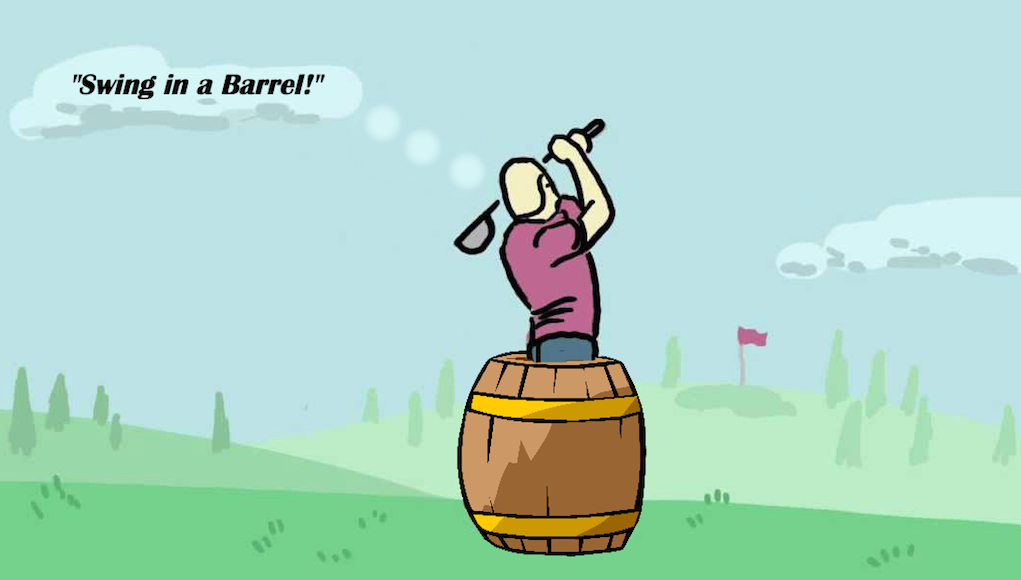
For whatever reason, golf is overrun with instructional clichés. You know:
- Keep Your Head Down
- Keep Your Left Arm Straight
- Swing in a Barrel
- Swing Easy When It’s Breezy
- Tee it High, and Let it Fly
- Drive for Show; Putt for Dough
While experienced golfers and instructors may squawk at these clichés, some of them can be extremely helpful when applied properly. Others, however, are far off base and will only lead to worse shots and more frustration. In this article, I’d like to examine the golf clichés above to see which of them can hold true, and which ones should be discarded.
Keep Your Head Down
Go to a public golf range on any random day at any random time, and I’ll bet you overhear someone utter the words, “Keep your head down.”
While this has been a great thought for many decades, players such as Henrik Stenson, David Duval and Annika Sorenstam have looked up long before impact and had great careers. A better thought would be to maintain your spine angle, or keep your distance from the ground. Keeping the head down is basically saying, “Hey, don’t raise up or you’re going to miss the ball entirely.” As such, the cliché focused on the part of the swing fault that most people could identify, the head, but it does not communicate the proper feeling to the golfer.
If it were up to me, we as a golfing community would change “keep your head down” to “stay in your posture.” Millions of golfers would be better for it.
Left Arm Straight
Homer Kelley said the “extensor action” of the rear arm helps to keep the forward arm straight back and through. Translation: It’s beneficial to maintain your basic arm width back and through the ball. There are some exceptions, though.
Curtis Strange won back-to-back U.S. Opens with a bent left arm in his backswing (it wasn’t floppy at the top, but slightly bent) and players such Lanny Wadkins, Lee Westwood, Jerry Pate, and Jordan Speith all have a slight loss of radius around the impact zone. While it’s not the best idea to have a loss of this lead arm width, it’s not essential to playing well. In general, however, instructing someone to “keep your left arm straight” won’t do much harm.
Swing in a Barrel
It’s funny how things that were discarded can come back in vogue. When I was a kid, there was a push toward loading up on the right side during the backswing, which encouraged a golfer to “lean over the right leg” with the upper-torso at the top. Over time, instruction shifted to having players staying more centered at address, to the top, and into impact. That’s how most golfers are taught to swing today, and “Swinging in a Barrel” is prevalent once again.
If you’re a golfer who is strong enough and possesses a good pivot motion, then swinging in this manner will work just fine, but it won’t work for everyone.
Swing Easy When It’s Breezy
My old college coach used to say this over and over and over… and over. I know what he was trying to say; basically, don’t let the wind make you lose your balance and affect impact.
Personally, I do advocate making sure you maintain your balance, but I don’t feel that swinging any easier in today’s game is the best idea. The holes aren’t getting any shorter. A better thought would be to focus on more centered impact rather than slowing down your swing. Whenever you hit the ball more solid, you transmit more energy into the ball and this added ball speed will help you to cut through the wind as best you can.
Tee It High, and Let It Fly
I LOVE this one. There is nothing better than standing on an elevated tee on a wide-open par-5 with a strong wind behind you!
Whenever you tee you ball a touch higher, you are adding some potential launch angle to your shot and hopefully it all balances out to longer drives. Remember your goal in teeing it higher is to contact the ball on the upper-center of the driver face so you can create a higher launch with less spin. That maximizes your distance potential. If you hit the ball off the bottom of the club, it will spin too much and you will actually lose distance.
Tee it high and let it fly whenever you can.
Drive for Show; Putt for Dough
Thanks to the work of Mark Broadie, we now understand just how important the drive off the tee can be (think: Dustin Johnson). Understanding that the driver can help you cut strokes from your game, I cannot stress enough that we drive for dough more than we all once thought. Figure out how to drive it long, and you might always be putting for the win.
Putting, while important, should hold a backseat to driving and iron play from 170-215 yards at the top levels. That being said, I would say that for amateur golfers at the lower levels, “putting for dough” would be better stated as “eliminate all three-putts.” Just limiting three putts would save the average player countless strokes, dropping their scores and raising their confidence in the process.
—
As it turns out, most of these common golf clichés are actually fairly helpful. But sometimes, the phrasing is a bit off, so be careful exactly what you choose to listen to, or what you tell your buddy at the range. Remember, we want to help a golfer who’s struggling… not make him worse!
- LIKE122
- LEGIT22
- WOW2
- LOL5
- IDHT1
- FLOP4
- OB0
- SHANK22
Instruction
The Wedge Guy: The easiest-to-learn golf basic
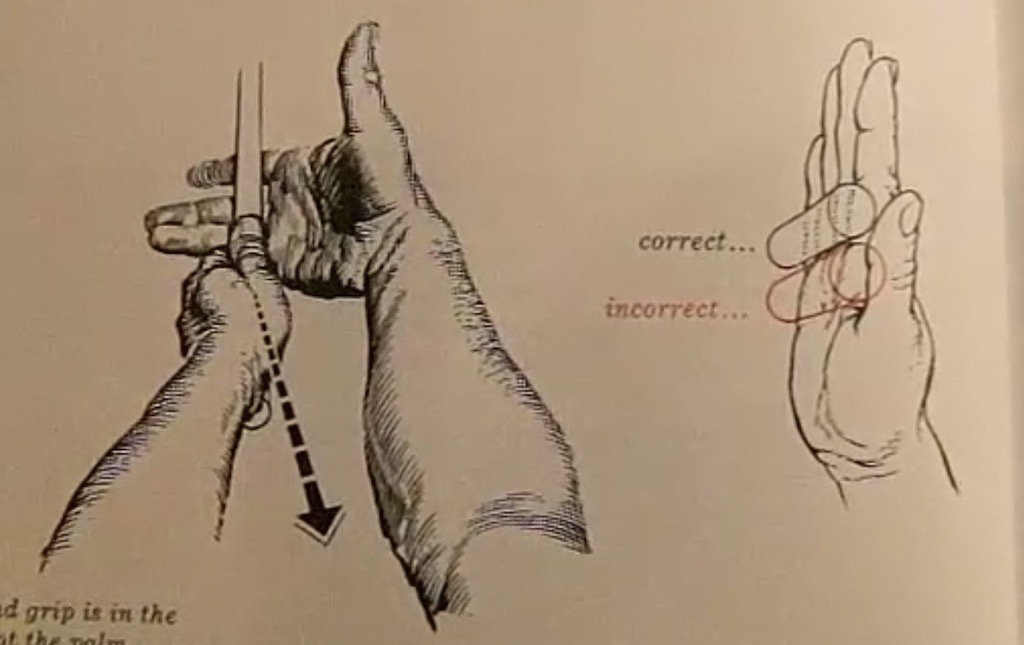
My golf learning began with this simple fact – if you don’t have a fundamentally sound hold on the golf club, it is practically impossible for your body to execute a fundamentally sound golf swing. I’m still a big believer that the golf swing is much easier to execute if you begin with the proper hold on the club.
As you might imagine, I come into contact with hundreds of golfers of all skill levels. And it is very rare to see a good player with a bad hold on the golf club. There are some exceptions, for sure, but they are very few and very far between, and they typically have beat so many balls with their poor grip that they’ve found a way to work around it.
The reality of biophysics is that the body moves only in certain ways – and the particulars of the way you hold the golf club can totally prevent a sound swing motion that allows the club to release properly through the impact zone. The wonderful thing is that anyone can learn how to put a fundamentally sound hold on the golf club, and you can practice it anywhere your hands are not otherwise engaged, like watching TV or just sitting and relaxing.
Whether you prefer an overlap, interlock or full-finger (not baseball!) grip on the club, the same fundamentals apply. Here are the major grip faults I see most often, in the order of the frequency:
Mis-aligned hands
By this I mean that the palms of the two hands are not parallel to each other. Too many golfers have a weak left hand and strong right, or vice versa. The easiest way to learn how to hold the club with your palms aligned properly is to grip a plain wooden ruler or yardstick. It forces the hands to align properly and shows you how that feels. If you grip and re-grip a yardstick several times, then grip a club, you’ll see that the learning curve is almost immediate.
The position of the grip in the upper/left hand
I also observe many golfers who have the butt of the grip too far into the heel pad of the upper hand (the left hand for right-handed players). It’s amazing how much easier it is to release the club through the ball if even 1/4-1/2″ of the butt is beyond the left heel pad. Try this yourself to see what I mean. Swing the club freely with just your left hand and notice the difference in its release from when you hold it at the end of the grip, versus gripping down even a half inch.
To help you really understand how this works, go to the range and hit shots with your five-iron gripped down a full inch to make the club the same length as your seven-iron. You will probably see an amazing shot shape difference, and likely not see as much distance loss as you would expect.
Too much lower (right) hand on the club
It seems like almost all golfers of 8-10 handicap or higher have the club too far into the palm of the lower hand, because that feels “good” if you are trying to control the path of the clubhead to the ball. But the golf swing is not an effort to hit at the ball – it is a swing of the club. The proper hold on the club has the grip underneath the pad at the base of the fingers. This will likely feel “weak” to you — like you cannot control the club like that. EXACTLY. You should not be trying to control the club with your lower/master hand.
Gripping too tightly
Nearly all golfers hold the club too tightly, which tenses up the forearms and prevents a proper release of the club through impact. In order for the club to move back and through properly, you must feel that the club is controlled by the last three fingers of the upper hand, and the middle two fingers of the lower hand. If you engage your thumbs and forefingers in “holding” the club, the result will almost always be a grip that is too tight. Try this for yourself. Hold the club in your upper hand only, and squeeze firmly with just the last three fingers, with the forefinger and thumb off the club entirely. You have good control, but your forearms are not tense. Then begin to squeeze down with your thumb and forefinger and observe the tensing of the entire forearm. This is the way we are made, so the key to preventing tenseness in the arms is to hold the club very lightly with the “pinchers” — the thumbs and forefingers.
So, those are what I believe are the four fundamentals of a good grip. Anyone can learn them in their home or office very quickly. There is no easier way to improve your ball striking consistency and add distance than giving more attention to the way you hold the golf club.
More from the Wedge Guy
- The Wedge Guy: Golf mastery begins with your wedge game
- The Wedge Guy: Why golf is 20 times harder than brain surgery
- The Wedge Guy: Musings on the golf ball rollback
- LIKE86
- LEGIT13
- WOW6
- LOL1
- IDHT0
- FLOP4
- OB1
- SHANK8
Instruction
Clement: Stop ripping off your swing with this drill!
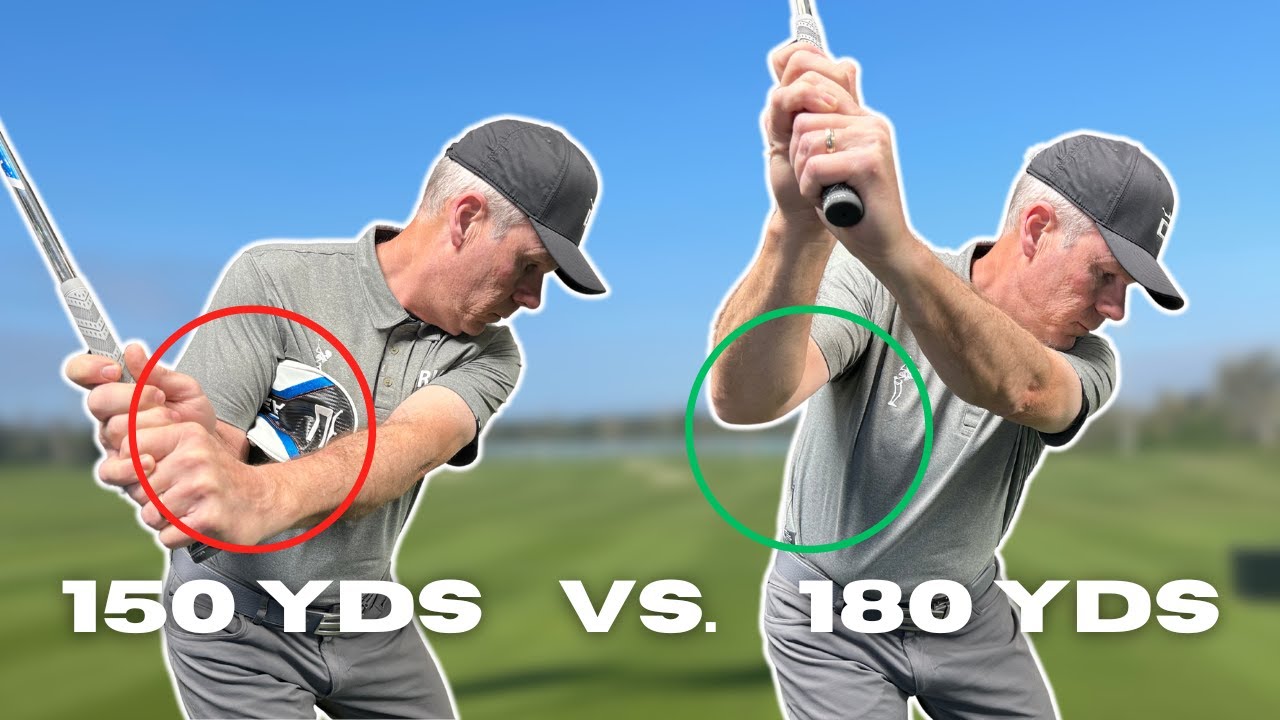
Not the dreaded headcover under the armpit drill! As if your body is defective and can’t function by itself! Have you seen how incredible the human machine is with all the incredible feats of agility all kinds of athletes are accomplishing? You think your body is so defective (the good Lord is laughing his head off at you) that it needs a headcover tucked under the armpit so you can swing like T-Rex?
- LIKE0
- LEGIT2
- WOW2
- LOL0
- IDHT0
- FLOP0
- OB0
- SHANK2
Instruction
How a towel can fix your golf swing
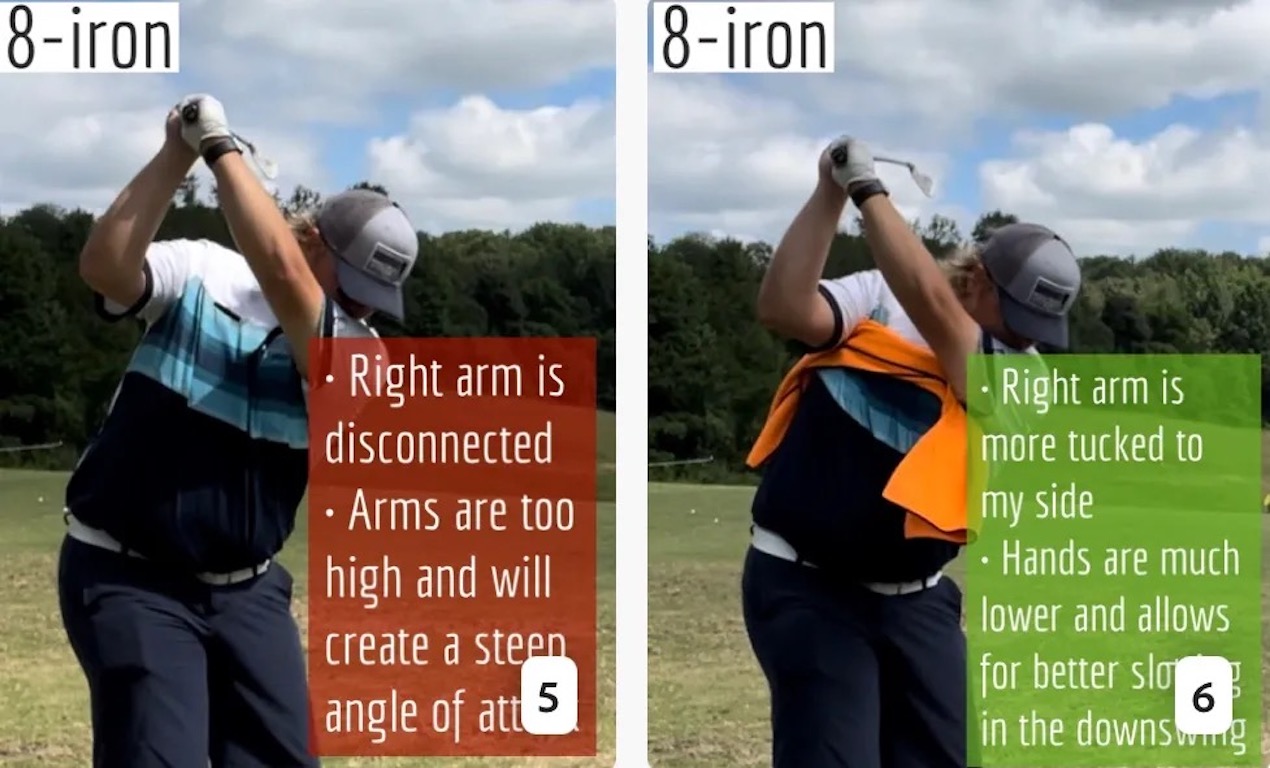
This is a classic drill that has been used for decades. However, the world of marketed training aids has grown so much during that time that this simple practice has been virtually forgotten. Because why teach people how to play golf using everyday items when you can create and sell a product that reinforces the same thing? Nevertheless, I am here to give you helpful advice without running to the nearest Edwin Watts or adding something to your Amazon cart.
For the “scoring clubs,” having a solid connection between the arms and body during the swing, especially through impact, is paramount to creating long-lasting consistency. And keeping that connection throughout the swing helps rotate the shoulders more to generate more power to help you hit it farther. So, how does this drill work, and what will your game benefit from it? Well, let’s get into it.
Setup
You can use this for basic chip shots up to complete swings. I use this with every club in my bag, up to a 9 or 8-iron. It’s natural to create incrementally more separation between the arms and body as you progress up the set. So doing this with a high iron or a wood is not recommended.
While you set up to hit a ball, simply tuck the towel underneath both armpits. The length of the towel will determine how tight it will be across your chest but don’t make it so loose that it gets in the way of your vision. After both sides are tucked, make some focused swings, keeping both arms firmly connected to the body during the backswing and follow through. (Note: It’s normal to lose connection on your lead arm during your finishing pose.) When you’re ready, put a ball in the way of those swings and get to work.
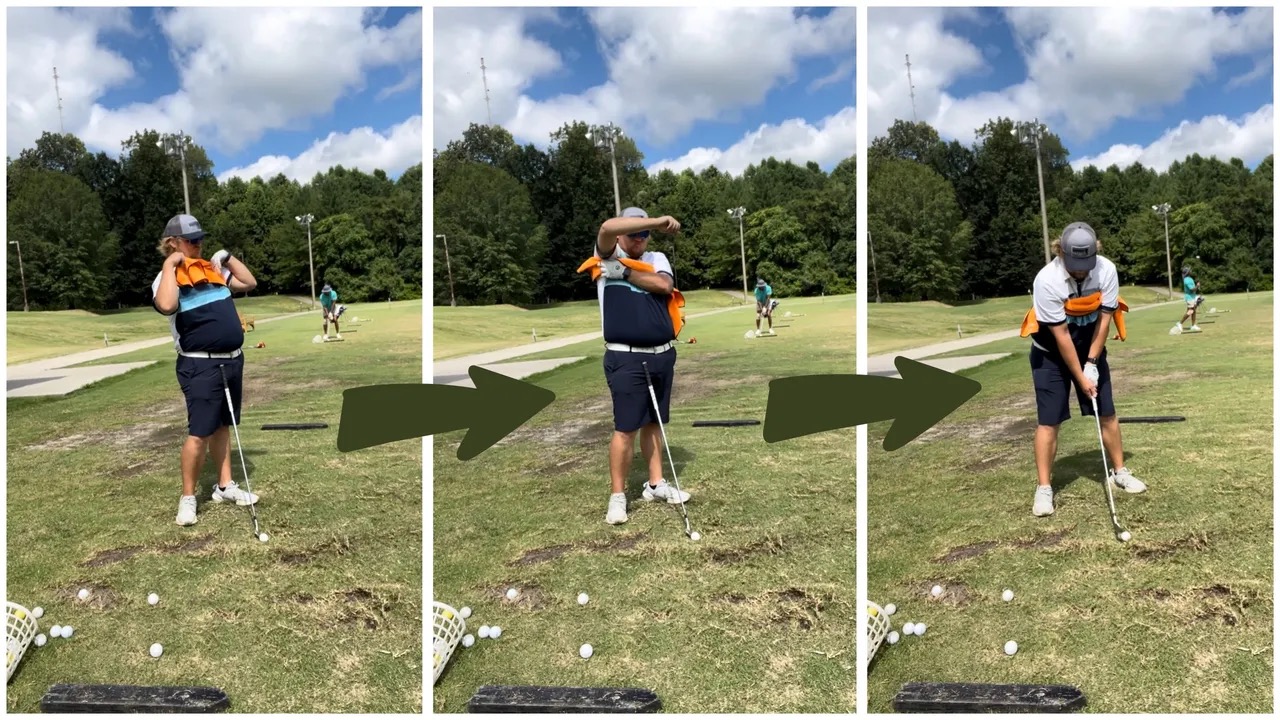
Get a Better Shoulder Turn
Many of us struggle to have proper shoulder rotation in our golf swing, especially during long layoffs. Making a swing that is all arms and no shoulders is a surefire way to have less control with wedges and less distance with full swings. Notice how I can get in a similar-looking position in both 60° wedge photos. However, one is weak and uncontrollable, while the other is strong and connected. One allows me to use my larger muscles to create my swing, and one doesn’t. The follow-through is another critical point where having a good connection, as well as solid shoulder rotation, is a must. This drill is great for those who tend to have a “chicken wing” form in their lead arm, which happens when it becomes separated from the body through impact.
In full swings, getting your shoulders to rotate in your golf swing is a great way to reinforce proper weight distribution. If your swing is all arms, it’s much harder to get your weight to naturally shift to the inside part of your trail foot in the backswing. Sure, you could make the mistake of “sliding” to get weight on your back foot, but that doesn’t fix the issue. You must turn into your trial leg to generate power. Additionally, look at the difference in separation between my hands and my head in the 8-iron examples. The green picture has more separation and has my hands lower. This will help me lessen my angle of attack and make it easier to hit the inside part of the golf ball, rather than the over-the-top move that the other picture produces.
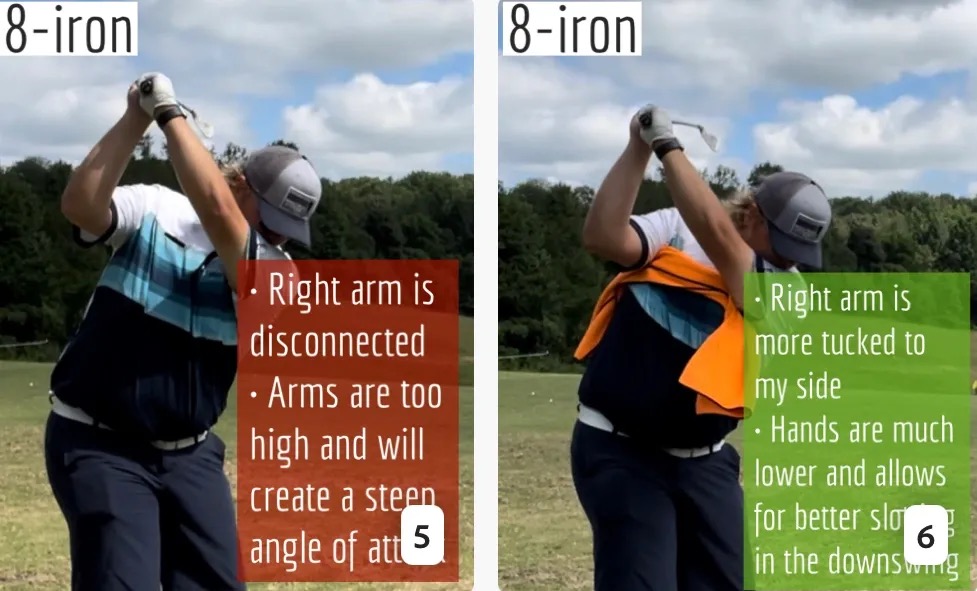
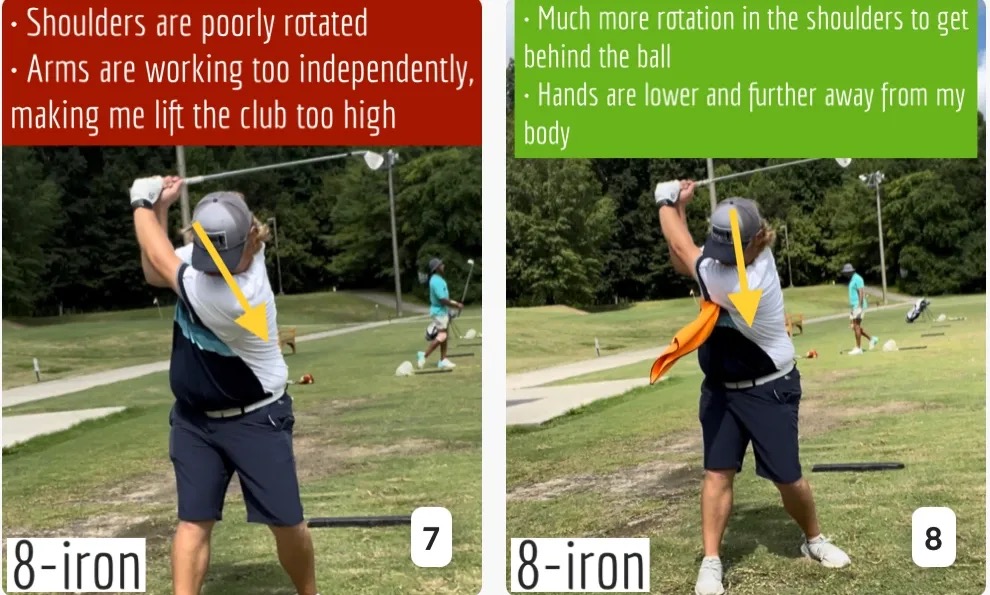
Stay Better Connected in the Backswing
When you don’t keep everything in your upper body working as one, getting to a good spot at the top of your swing is very hard to do. It would take impeccable timing along with great hand-eye coordination to hit quality shots with any sort of regularity if the arms are working separately from the body.
Notice in the red pictures of both my 60-degree wedge and 8-iron how high my hands are and the fact you can clearly see my shoulder through the gap in my arms. That has happened because the right arm, just above my elbow, has become totally disconnected from my body. That separation causes me to lift my hands as well as lose some of the extension in my left arm. This has been corrected in the green pictures by using this drill to reinforce that connection. It will also make you focus on keeping the lead arm close to your body as well. Because the moment either one loses that relationship, the towel falls.
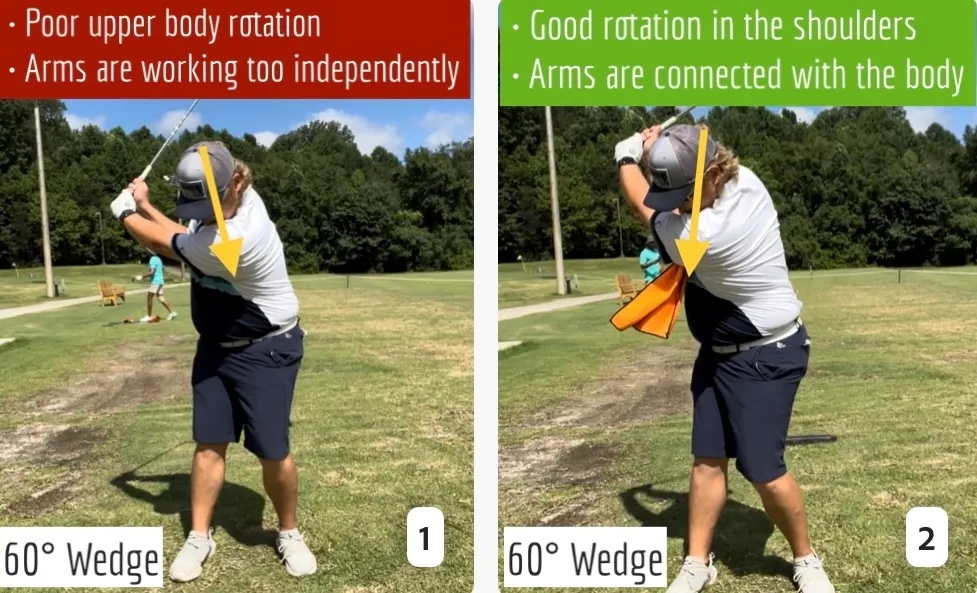
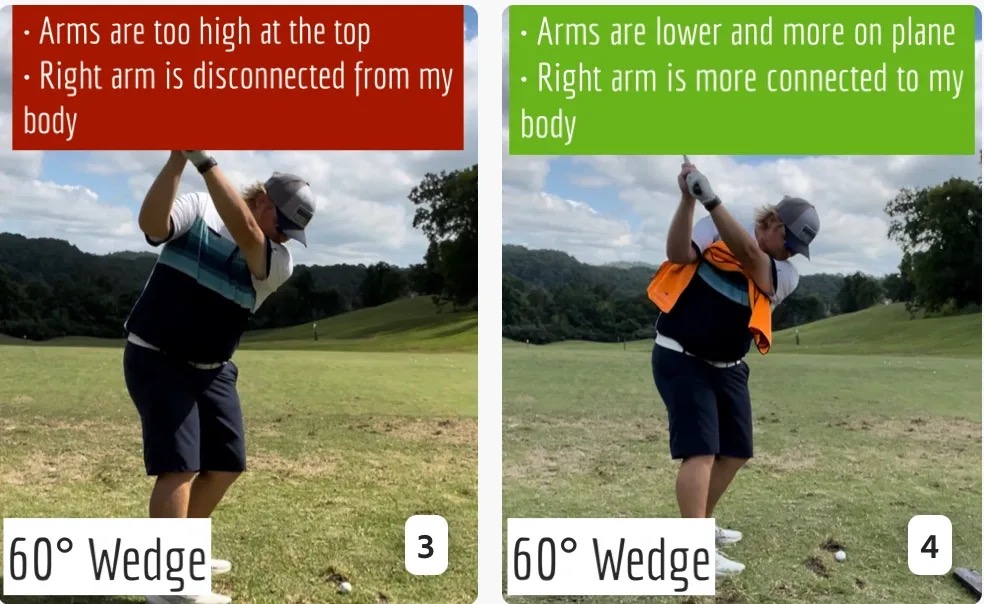
Conclusion
I have been diligent this year in finding a few drills that target some of the issues that plague my golf game; either by simply forgetting fundamental things or by coming to terms with the faults that have bitten me my whole career. I have found that having a few drills to fall back on to reinforce certain feelings helps me find my game a little easier, and the “towel drill” is most definitely one of them.
- LIKE12
- LEGIT2
- WOW2
- LOL0
- IDHT0
- FLOP2
- OB0
- SHANK8
-

 19th Hole1 week ago
19th Hole1 week agoDave Portnoy places monstrous outright bet for the 2024 Masters
-
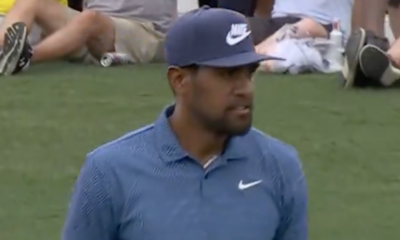
 19th Hole3 weeks ago
19th Hole3 weeks agoThings got heated at the Houston Open between Tony Finau and Alejandro Tosti. Here’s why
-
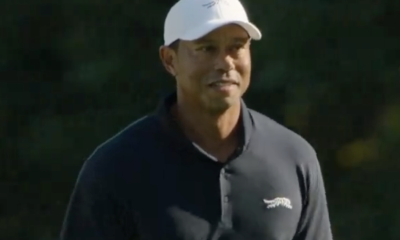
 19th Hole2 weeks ago
19th Hole2 weeks agoTiger Woods arrives at 2024 Masters equipped with a putter that may surprise you
-
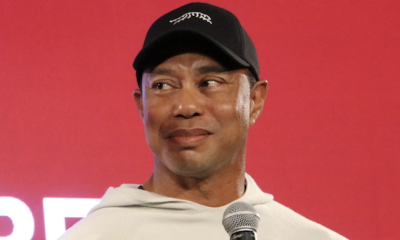
 19th Hole2 weeks ago
19th Hole2 weeks agoReport: Tiger Woods has ‘eliminated sex’ in preparation for the 2024 Masters
-
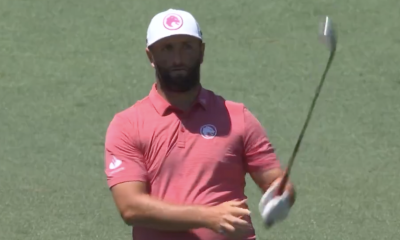
 19th Hole5 days ago
19th Hole5 days agoTwo star names reportedly blanked Jon Rahm all week at the Masters
-

 19th Hole5 days ago
19th Hole5 days agoNeal Shipley presser ends in awkward fashion after reporter claims Tiger handed him note on 8th fairway
-
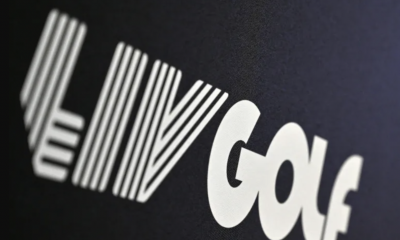
 19th Hole4 days ago
19th Hole4 days agoReport: LIV Golf identifies latest star name they hope to sign to breakaway tour
-

 19th Hole3 weeks ago
19th Hole3 weeks agoAddiction, spinal fusion, and scam artists – Everything Anthony Kim revealed in candid interview with David Feherty









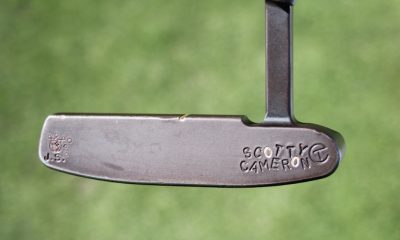

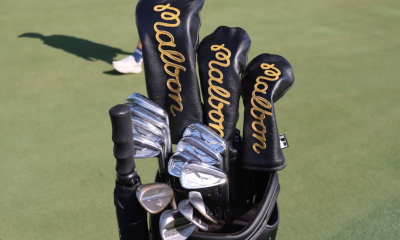



Michael
Jul 12, 2017 at 12:24 am
When it’s breezy Swing Easy – I’ve always been instructed to take an extra club or two and THEN Swing Easy. I would agree that it’s not good advice to use your normal club in a headwind and swing easy. But if this phrase is imparted with the advice to club up – then Swing Easy is good advice.
Rich Douglas
Jul 1, 2017 at 10:16 pm
Can’t agree with the left-arm-straight advice. For too many golfers, this introduces destructive tension into the swing. For most, better to let the arm bend a bit at the top, but allow it to return to being straight in the hitting zone. Yes, a “long” left (front) arm will widen the swing and should add speed to the clubhead, but the price paid for this is often stiff, wild shots.
Tension is a killer. Don’t invite it in.
stephenf
Jul 6, 2017 at 1:02 am
True, if you see straight as rigid (which promotes tension). “Comfortably extended” is the best description I’ve ever heard or used with students back when I was teaching.
What you’re saying here is pretty much identical to Penick — doesn’t have to be straight at the top, but “straight” as in responding to centrifugal force and trying to fly outward at impact is ideal. That’s good company.
Guia
Jun 30, 2017 at 7:14 pm
Most people use cliches don’t have anything original to say, and usually use them in the wrong place. Drive for show, putt for dough………..I hate that!
Also, Trevino, Nicklaus, Palmer, etc said this…….usually these cliches are attributed to the wrong person and are out of ignorance.
The more someone quotes something they heard, the more boring the person.
And, you can take that to the bank :}
UdderBollix
Jun 30, 2017 at 2:57 am
I’ve got the best one for ya:
“Golf is a game that anybody can play!”
What a horrible cliché that is, and what a load of completely and utter bollocks
Jaybird
Jun 29, 2017 at 6:56 pm
All you have to do is get a set of PXG irons and you will never have to worry about all these cliches again.
Andrew Cooper
Jun 29, 2017 at 2:25 pm
The problem with cliches like “not lifting your head” (or “coming out of your posture”) and “keep your left arm straight” and lots of others, is that they deal with effects not causes. They are what we see.
How many golfers are in great shape coming into impact and then simply come up out of their posture? Leaving physical issues aside, I’d say mostly it’s a reaction, usually to a steep downswing-the body lifts up to stop slamming the club into the ground. That’s why try as hard as they can to “keep their head down”, they simply can’t.
Likewise, how many golfers with a good grip, posture and decent flexibility simply collapse their lead arm? Golfers who bend their lead arm excessively do so because they can’t make a backswing otherwise.
Square
Jun 29, 2017 at 2:10 pm
Hold the club like you’re holding a bird. Not tight enough to hurt the bird but tight enough so it can’t fly away.
Alex
Jun 29, 2017 at 1:37 pm
Cliches are not helpful in the long run in any sport or profession. Fodder for the ignorant bandwagon types attempting to sound intelligent. For instance: Tiger Woods! Best golfer ever!
Phil
Jun 29, 2017 at 1:24 pm
Grip it and Rip it!
Desmond
Jun 29, 2017 at 12:49 pm
Isn’t the “tee it high, let it fly” outdated a bit? Todays’ designs seem to indicate just above center contact, not necessarily high contact. High contact gets one a very high ball, which does not always translate into more yards. In fact, you “leave yards on the table.”
TR1PTIK
Jun 29, 2017 at 2:29 pm
I think the main idea behind tee it high let if fly is to strike the ball on the upswing. Hitting the ball near the crown of the club won’t do much for anyone regardless of the wind. Striking the ball just above center on the clubface with an upward attack angle should almost always result in higher launch and lower spin. It requires a different swing than what you might normally put on the ball and that’s obviously where people get confused.
Desmond
Jun 29, 2017 at 9:38 pm
Yes, I agree with all of your reply – that was my understanding, but that’s not what the article stated. Thx.
Mike
Jun 29, 2017 at 10:05 am
I always though “Swing easy when it’s breezy” was to keep lower spin rate so the wind doesn’t make the spin out of control, such as a slice into a heavy wind could cause a boomerang ball flight.
Jon
Jun 29, 2017 at 10:53 am
I’m right with you Mike. I was always told to take more club and only make about a 3/4 swing to keep the spin rate down.
Terry
Jun 29, 2017 at 2:43 pm
Jack agrees with you guys as well!
J-Tizzle
Jun 29, 2017 at 1:46 pm
Yes this 100%.
And I’ll disagree to some extent in my personal opinion on “drive for show and putt for dough”. I think the worse the golfer, the more important putting is to their overall score. Sure putting is important for everyone that plays the game, but DJ, while maybe not being a fantastic putter by TW 2000 standards, the worst putter on tour is still probably a better putter than anyone you know. Its crazy how quick a good putt can fix a messy hole. I’d rather be regarded as an excellent putter than an excellent driver of the golf ball any day of the week.
TR1PTIK
Jun 29, 2017 at 2:25 pm
Considering most beginners struggle to find their tee shot – I’d say driving is definitely more important. Especially when factoring for penalties such as OB or Water. A 3-jack is nothing compared to a drive OB that needs to be re-teed (even if only playing as a one-stroke penalty). Once you can locate the ball on the golf course, by all means work on putting.
J-Tizzle
Jun 29, 2017 at 5:03 pm
I’d say if anything the article is too vague. While I do agree, if you can’t find your ball you’re racking up penalty shots. If you look at a lets say 18ish handicapper, the putting becomes more important because they’re not totally missing the ball and losing strokes out of their mind on the tee ball typically, but rather wasting shots around the green. But I wholly get your point for sure.